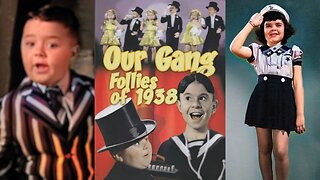LONESOME (1928) Barbara Kent, Glenn Tryon & Fay Holderness | Comedy, Drama, Romance | B&W
Lonesome is a 1928 American sound part-talkie comedy drama film directed by Paul Fejös, and starring Barbara Kent and Glenn Tryon. Although containing a few sequences with audible dialog, the majority of the film had a synchronized musical score with sound effects with English intertitles. The film was released in both sound-on-disc and sound-on-film formats. Its plot follows two working-class residents of New York City over a 24-hour-period, during which they have a chance meeting at Coney Island during the Independence Day weekend and swiftly fall in love with one another. It was produced and distributed by Universal Pictures.
In 2010, it was selected for preservation in the United States National Film Registry by the Library of Congress as being "culturally, historically, or aesthetically significant".
It was remade in 1935 as a comedy called The Affair of Susan.
SYNOPSIS
Two lonely people in the big city meet and enjoy the thrills of an amusement park, only to lose each other in the crowd after spending a great day together.
In New York City, Mary is a telephone operator who lives alone and is lonely. Jim is a factory worker who also lives alone, and feels disconnected from the world. During the Independence Day weekend, both Mary and Jim decide to visit Coney Island alone after finishing their Saturday half-day work shifts. The two board the same bus, mutually catching the other's attention, and again encounter each other once they arrive at the beach.
After the two spend some time together on the beach, Mary realizes she has lost the wedding ring she wears. Jim helps her locate it, but is disheartened, believing she is married. Mary reassures him after they find the ring that it is only her mother's wedding band. As night falls, Mary laments the fact that their day together is over, but Jim assures her it is not, and they continue to spend time together at the amusement park, visiting a fortune teller and riding amusement park rides. The two ride the Cyclone rollercoaster, but after one of the cars crashes, a melee ensues among the parkgoers, during which Mary and Jim are separated.
Only knowing each other's first name, and having only a small photo of each other, Jim and Mary are desperate to find each other. Jim attempts to locate Mary in the park, but a rainstorm causes further complications, sending the hundreds of park visitors scattering. A defeated Jim leaves Coney Island by train, as does Mary. Mary retreats to her apartment, where she begins to cry and beat her hands against the walls in despair.
CAST & CREW
Barbara Kent as Mary
Glenn Tryon as Jim
Fay Holderness as Overdressed Woman
Gustav Partos as Romantic Gentleman
Eddie Phillips as The Sport
Andy Devine as Jim's Friend
Directed by Paul Fejös
Written by Tom Reed, Edward T. Lowe Jr.
Story by Mann Page
Produced by Carl Laemmle, Carl Laemmle Jr., Oskar Schubert-Stevens
Cinematography Gilbert Warrenton
Edited by Frank Atkinson
Distributed by Universal Pictures
Release dates June 20, 1928 (Silent Version), September 30, 1928 (Sound Version)
Running time 69 minutes (Silent Version), 75 minutes (Sound Version)
Country United States
Language English
NOTES
Production
Lonesome, with a three-page outline, was originally intended, by the studio, to be a short, Fejös adapted the outline to feature length.
Lonesome has few intertitles.
The studio forced, and Fejos did not direct, three dialogue sequences, with primitive dialogue, and stationary camera, into the film for commercial attraction. Sound design features the repeated use of Irving Berlin's Always.
Lonesome was widely released in the sound version. The silent version was mainly seen in theatres that had not yet converted to sound (e.g., theatres in rural areas that could not afford the expense of converting to sound). Some scenes in existing original prints of the film are colored with stencils (purple). By the time it was ready for general release, Lonesome has been equipped with a synchronized soundtrack, with music, sound effects, and three dialogue scenes. The studio promoted the film as a sound film.
Cinematography includes: superimposition effects, experimental editing, roller-coasting camera, roving camera, fast motion, split screens, model work, matte paintings, hand-held shots and dolly shots.
Reception
Jonathan Rosenbaum wrote: "...Paul Fejos’s exquisite, poetic 1928 masterpiece about love and estrangement in the big city, deserves to be ranked with The Crowd as well as Sunrise, though it’s not nearly as well-known as either".
In October 1928, Mordaunt Hall wrote: "...suggests an O Henry story without that author's keen insight into human nature. It is agreeable and interesting, a relief in many respects from the cut and dried picture formula so frequently set forth as a narrative. But there are a number of episodes where Dr. Fejos's imagination seems stunted".
-
 21:23
21:23
Lost n Found Films
20 days agoOUR GANG FOLLIES (1938) George 'Spanky' McFarland, Carl 'Alfalfa' Switzer, Darla Hood | Comedy | B&W
57 -
 9:39
9:39
Tactical Advisor
1 day agoHow To Improve Your Shooting For FREE! Mantis Blackbeard X
10.2K6 -
 1:00:59
1:00:59
Squaring The Circle w/ Randall Carlson
21 hours ago#007 The Real Climate Crisis Noone Is Talking About and Mount Tambora Pt 2
11.9K9 -
 13:52
13:52
America Uncovered
21 hours agoEveryone is WRONG About Trump's Guilty Verdict
7.5K26 -
 13:10
13:10
Censored TV
20 hours agoThe Owen Benjamin vs Jim Goad debate was WILD
9.14K13 -
 25:27
25:27
Degenerate Plays
12 hours agoThe Microtransaction Master - Call Of Duty Modern Warfare Remastered : Part 3
8.31K1 -
 21:03
21:03
MYLUNCHBREAK CHANNEL PAGE
15 hours agoOld World Minnesota?
13.1K17 -
 5:49:05
5:49:05
Akademiks
22 hours agoDrake Next Move - Whats next?? Did Lil Baby Listen to Me? Diddy and Family Preparing for Indictment?
68K36 -
 1:56:06
1:56:06
TimcastIRL
1 day agoTrump Raises RECORD $52.8 MILLION In One Day, Bonus Uncensored Show w/Laura Loomer | Timcast IRL
88.2K375 -
 23:19
23:19
Scammer Payback
4 days agoWe Created the First Ever 𝗔𝗡𝗧𝗜-𝗦𝗖𝗔𝗠 Call Center
212K250